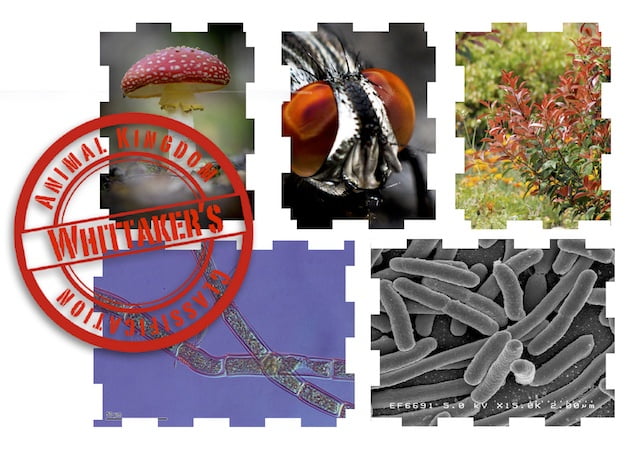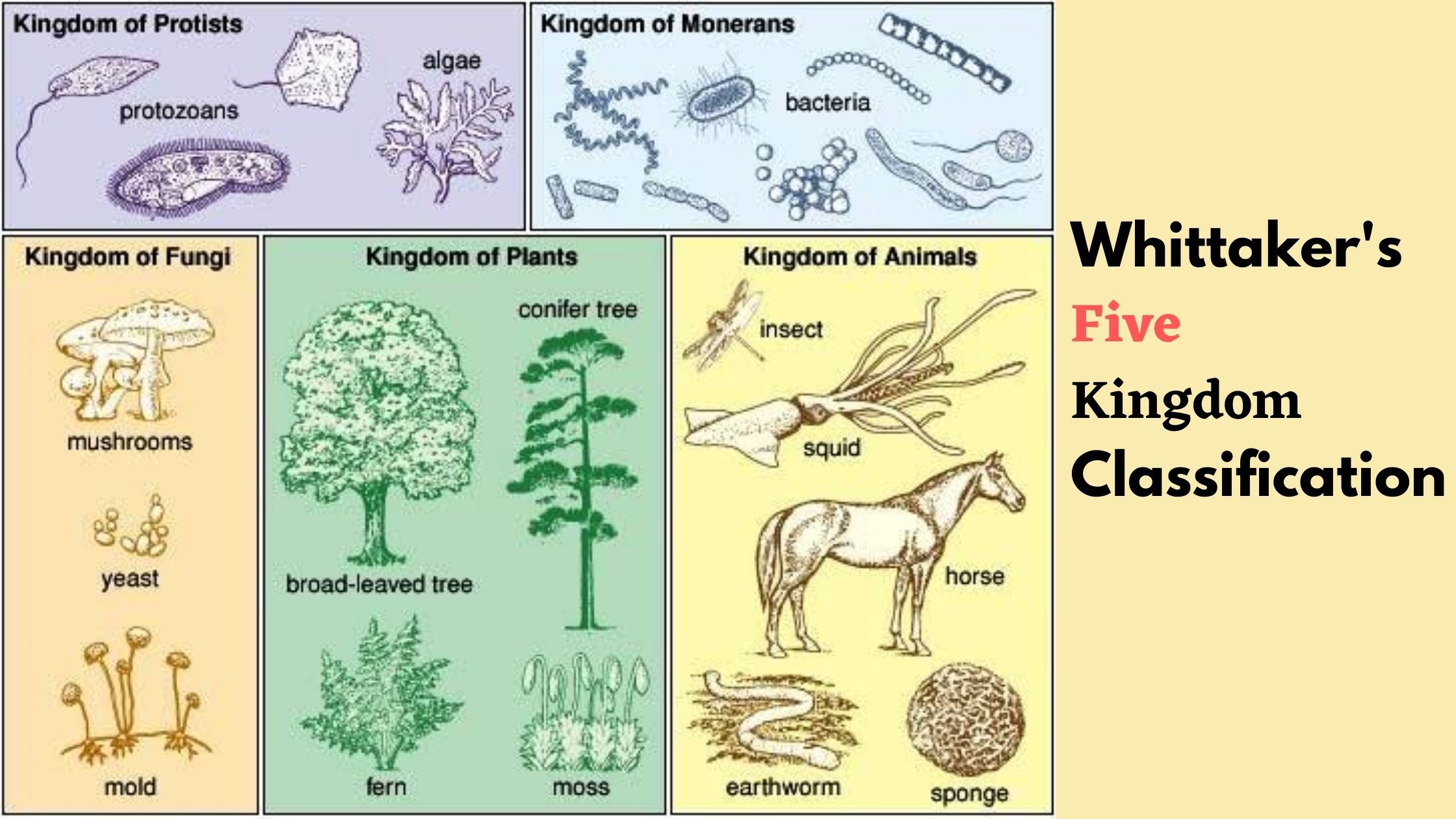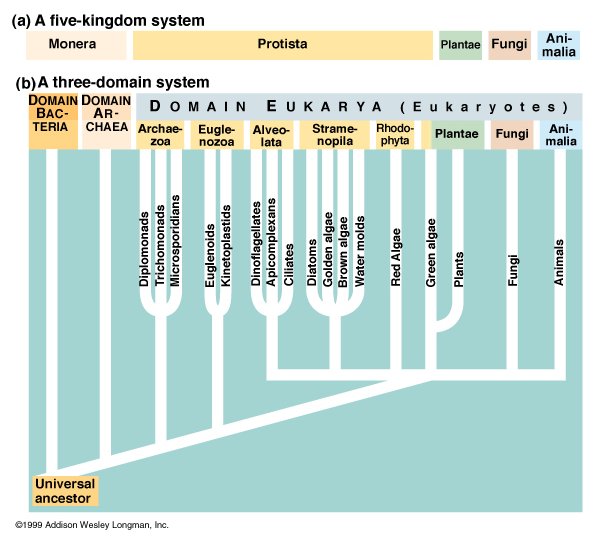Viruses Are Not Classified in Any of Whittaker's Five Kingdoms.
Whittaker five kingdom classification was proposed by scientist RH Whittaker in 1969. Viruses are tiny infectious agents that rely on living cells to multiply.

Five Kingdom System Of Classification Features And Limitations
This system was developed by Robert H.

. Whittaker in 1969 and was based on the work done by previous biologists like Carolus Linnaeus. Humans using yeast to make beer and wine. The five-kingdom classification is followed by India.
Organisms are placed into these categories based on similarities or common characteristics. Dust in it was a source of living Micro organisms. Bacteria Archaea weird bacteria-like microbes and Eukarya unicellular and multicellular organisms such as fungi plants and animals that possess nucleated cellsUnder this classification system viruses are left out in the cold.
The Virus Comes Under Which Kingdom. Option 3 Mode of nutrition. Four of the five kingdoms consist of eukaryotic organisms.
Option 4 Complexity of body organization. Biologists have categorized life into three large domains. Kingdom Plantae consists of all the plants on the earth.
Option 2 Mode of reproduction. Viruses are not included in the Five-Kingdom System of Classification because they are not living cells. Viruses ARENT classified in any kingdomSHOCKEDdont be because while you are on the look out for their classification viruses are in a dilemma on whether they are living or.
Viruses are not classified in any of Whittakers five kingdoms. In the same Whittaker in 1959 classified living organisms into following five kingdoms or broad categories. There is ongoing debate as to whether viruses can be.
According to this classification the five kingdoms are Kingdom Monera Protista Fungi Plantae and Animalia. Viruses are those poor guys who are not invited to any parties. Whittaker is not based on.
The criteria for this classification was. As such there is some debate as to whether or not viruses should be considered living organisms. The five kingdom classification are- Monera Protista Fungi Plantae and Animalia.
In which level of organization would viruses exist. They may use an animal plant or bacteria host to survive and reproduce. Viruses are not included in any of the kingdom as because viruses are not living organisms despite having their own DNA.
The classification of living things into five kingdoms The first person to divide living things into five broad kingdoms was North American ecologist Robert Whittaker. Kingdom Animalia contains all the animals and it is the largest among the five-kingdom classification. Viruses are acellular organisms which are excluded from Whittakers five kingdom classification.
Viruses are classified by phenotypic characteristics such as morphology nucleic acid type mode of replication host organisms and the type of disease they cause. Structure of Cells - prokaryotic or eukaryotic Structure of Organism - unicellular or Multicellular Mode of nutrition - Photosynthesis in green plants absorption in fungi and ingestion in animals. View the full answer.
Organisms are classified into three Domains and into one of six Kingdoms of life. Some of the characteristics that are used to determine placement are. QUESTION 4 Viruses are not classified in any of Whittakers 5 kingdoms.
The Kingdoms are further classified. The International Committee on Taxonomy of Viruses uses the taxonomic rank kingdom for the classification of viruses with the suffix -virae. Kingdom Monera Prokaryotic bacteria and blue green algae.
Activity is an example of biotechnology. Kingdom does not contain any eukaryotes. Whittaker has given the famous Five- Kingdom Classification.
These Kingdoms are Archaebacteria Eubacteria Protista Fungi Plantae and Animalia. They certainly are not alive in the classical sense because they are not capable of. Viruses are noncellular obligate intracellular parasites.
These kingdoms are divided on the basis of Number of cells Cell type Cell wall Mode of nutrition and. The formal taxonomic classification of viruses. Viruses are not made up of living cells so they do not belong to any particular kingdom.
A Eukaryotic or Prokaryotic based on complexity of cell structure. 24 VIRUSES VIROIDS PRIONS AND LICHENS In five Kingdom System of classification by Whittaker Viruses Viroids Prions and Lichens is not mentioned. Whittaker proposed the five kingdom classification.
Viruses do not come under any kingdom. These are eukaryotic organisms with well-developed organelles. This researcher proved in 1959 that fungi were not plant organisms - previously it was thought that they were - and a decade later he proposed the creation of the fungi kingdom.
Up to 24 cash back 6 Kingdoms Viruses. They do not have any place in 5 kingdom system. Each kingdom consists of divisions or phyla which in turn are divided into classes orders families genera and species.
Answer 1 of 2. The organisms which are placed under the kingdom Animalia are heterotrophic and depend on the other organisms for food. The Five Kingdom Classification is one of the most common ways to group living beings based on their characteristics like cell structure body organization mode of nutrition source of nutrition reproduction and interrelationship with others.
The function only when the get inside the body of other multicellular organisms such as humans. They are merely strands of DNA or RNA surrounded by a. VirusesViruses did not find a place in classification since they do not have a cell structure and are not true living beings.
But this is beneath the top level classifications of realm and subrealm. Option 1 Presence or absence of a well defined nucleus. This is the five kingdom classification given by scientist Whittaker 1969This scheme was based on -.
Virus classification is the process of naming viruses and placing them into a taxonomic system similar to the classification systems used for cellular organisms. A virus that is outside of a host cell is known as a virion. Five kingdom system of classification suggested by RH.

Question Video Recalling The Names Of The Five Kingdoms Nagwa
What Is The Answer To The 11th Biology Five Kingdom Classification Long Question Quora

Whittaker Classification Five Kingdoms Easy N Quick Read Theory Biokimicroki

Mechanism Of Enzyme Action Biochemical Chemical Bond Enzymes

Induced Fit Model Of Enzyme Action Enzymes Chemical Changes Active Site

Five Kingdom Classification Whittaker Youtube

Why Do Root Hair Cells Not Have Chloroplasts Biology Quiz Plant Cell Organelles Root

Mitochondria Structure And Function With Diagram Mitochondria Structure And Function Oxidative Phosphorylation

Whittaker S System Of Classification Five Kingdom System Of Classification Teaching Biology Kingdom Fungi General Biology

5 Kingdom Classification Gcse Biology 9 1 Youtube

Definition Of Mass Number With Examples Isoptopes Mass Number Definition Of Mass Atomic Mass Unit

Biology 5 Kingdoms By R Whittaker Diversity In Living Organisms Part 3 English Youtube

Mitochondria And Chloroplasts Worksheet Pdf Download Mitochondria Chemical Energy Worksheets

Whittaker S Five Kingdom Classification Advantages And Limitations

Five Kingdoms Vs Three Domains
In Which Kingdom The Viruses Are Placed In Whittaker Five Kingdom System Quora



Comments
Post a Comment